Foliage Gardening with the Elements of Design
Photos courtesy of Jenkins Arboretum & GardensYou don't need flowers for drama in your garden
Many gardeners have spent years seeking out plants with that elusive combination of four-season interest, ease of maintenance and striking features. While we often turn to showy flowers, eye-catching fruit, or ornamental bark to add interest to our garden design, we may be overlooking a simple, yet powerful design tool for our home landscapes — foliage!
 By applying the principles of design to your approach to growing foliage plants, you can quickly create a gorgeous — and easy to maintain — garden.
By applying the principles of design to your approach to growing foliage plants, you can quickly create a gorgeous — and easy to maintain — garden.
Turn your memory back to high school art class to revisit the elements of design: shape, color, space, form, line, value and texture. Together these elements create visual interest in a work of art, catching the eye of the viewer and leading them through the piece.
In a similar manner, these elements of design can engage the eye and draw a visitor into and through a garden space. While all seven elements are important to consider when designing or maintaining a garden, texture, color and form might be the three to focus on first for the most dramatic impact in your home landscape.
Texture
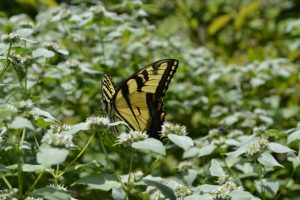
Here at Jenkins Arboretum & Gardens, we specialize in plants that are native to the northeast region. With this particular palette of plants, there are often long stretches of the year that are have fewer flowers in bloom and are instead dominated by the color green.
One way we add variety and visual engagement to the gardens is to plant a diversity of textured foliage. From the fuzzy leaves of mountain mint (Pycnanthemum muticum) to the glossy leaves of Southern magnolia (Magnolia grandiflora), the waxy pads of eastern prickly pear cactus (Opuntia humifusa) to the rough leaves of oakleaf hydrangea (Hydrangea quercifolia), nature’s textures are found throughout the garden.
Color
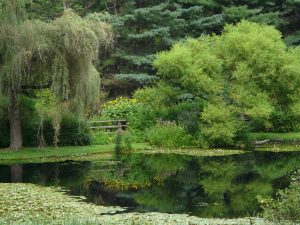 The word “green” simply does not do justice to the wide variety of colors we use the word to describe. When using the elements of design, an entire garden can be planted in only green hues, yet still be attractive and inviting.
The word “green” simply does not do justice to the wide variety of colors we use the word to describe. When using the elements of design, an entire garden can be planted in only green hues, yet still be attractive and inviting.
At Jenkins, we look for contrasting green colors to add drama to the garden. For example, down on the pond’s edge, we planted the blue-green foliage of swamp rattlesnake master (Eryngium yuccifolium) alongside the soft buttery green leaves of the American lotus (Nelumbo lutea). The combination of these two shades of green — along with their striking difference in texture (spiky against smooth) and form (narrow and upright next to low and round) — create a dramatic and eye-pleasing planting. This is one of our most-photographed spots in the garden … all because of the foliage!
Form
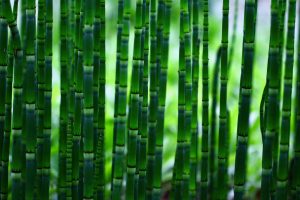
First a quick refresher from art class: shape and form differ in that shape is generally a two-dimensional element, while form depicts three dimensions. Designing a garden space is certainly different from painting on a flat canvas, but it’s still important to consider the form of plants and the space they occupy in the landscape.
Some plants take on a tall, upright form, such as scouring rush horsetail (Equisetum hyemale), while others sport rounded, bold foliage, such as Canadian wild ginger (Asarum canadense). Other types of forms to look for in the garden are cascading, vase, mounding or arching. Just as with texture or color, the design element of form thrives on contrast. Play with the differences in form to see what catches your eye in the garden.
And More
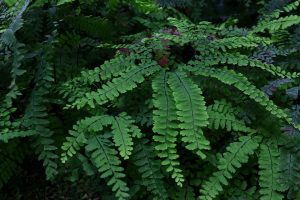 With all the elements of design, there are a few additional considerations. When planting a variety of foliage plants, keep in mind that too much variety in a small space can dull the impact of any one foliage and can quickly look messy or undefined to the eye.
With all the elements of design, there are a few additional considerations. When planting a variety of foliage plants, keep in mind that too much variety in a small space can dull the impact of any one foliage and can quickly look messy or undefined to the eye.
One way to avoid this visual messiness is to plant en masse to create a dramatic look. Large, graceful sweeps of the same plant create a bold visual statement and an impactful presence.
As we all know, rules are meant to be broken. So while some plants do best in large groupings, it can also be fun and dramatic to play with the contrasts between plants. Plant dissimilar foliage types next to each other in larger drifts or place an unexpected “pop” of a different kind of foliage in the middle of a grouping.
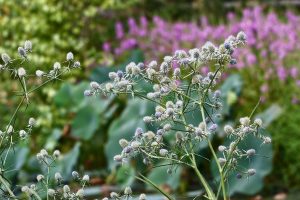
The elements of design are useful when designing a home landscape but can easily be applied to small container plantings as well. Be mindful of the texture, color and form of the plants you choose to combine in a container, and you’re sure to add some “wow” to your front porch or patio.
Keep the elements of design in mind as you work in the garden this season and have fun “painting” your masterpiece!
Jenkins Arboretum & Gardens is a 48-acre public garden showcasing native flora of the eastern United States and a world-class collection of rhododendrons and azaleas. The gardens are open every day of the year and are always free. Plan your visit by visiting Jenkins online at JenkinsArboretum.org.
Our Favorite Resources
- B&D Builders
- Ball & Ball
- Berk Hathaway Holly Gross
- Berk Hathaway Kit Anstey
- Berk Hathaway M. Schwartz
- Canvas Valley Forge
- Dewson Construction
- DiSabatino Landscaping
- King Construction
- McComsey Builders
- Monument/Sotheby’s Int’l
- Mostardi Nursery
- Mountaintop Construction
- Renewal Dynamics
- Sheller Energy
- White Horse Construction
